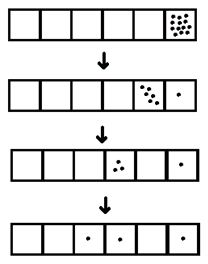Exploding Dots
1.6 Solutions
As promised, here are my solutions to the questions posed.
1. a) Here’s how the code appears from thirteen dots.

b) The number fifty has code \(110010\).
2. Assuming we want to make the agreement that we’ll always choose to explode dots if we can, then the code \(100211\) is not complete: the two dots in the third-to-last box can explode to give a final code of \(101011\).
3. This is the code for the number nineteen. (Well see next lesson a swift way to see this.)
4. a) Do it! b) Do this one too! c) You’re on a roll. Do this third one as well!
5. Again, if we agree to do all the explosions we can, then this code is not complete: three of the dots in the second-to-last box can explode to give \(2111\).
6. The number thirty-five has this code.
7. “Four dots in any one box explode and a replaced by one dot one place to the left.” The number thirteen has code \(31\) in a \(1 \leftarrow 4\) machine.
8. \(23\)
9. \(14\)
10. \(22\)
11. \(22\) (Same code as the previous answer – but, of course, the interpretation of the code is different.)
12. a) \(13\) b) \(37\) c) \(5846\) (These are the codes we use for numbers in everyday life!)
Resources
Books
Take your understanding to the next level with easy to understand books by James Tanton.
BROWSE BOOKS![]()
Guides & Solutions
Dive deeper into key topics through detailed, easy to follow guides and solution sets.
BROWSE GUIDES![]()
Donations
Consider supporting G'Day Math! with a donation, of any amount.
Your support is so much appreciated and enables the continued creation of great course content. Thanks!
Ready to Help?
Donations can be made via PayPal and major credit cards. A PayPal account is not required. Many thanks!
DONATE![]()


